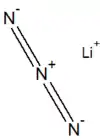Lithium azide
Lithium azide is the lithium salt of hydrazoic acid. It is an unstable and toxic compound that decomposes into lithium and nitrogen when heated.
 | |
 | |
| Names | |
|---|---|
| IUPAC name
lithium azide | |
| Identifiers | |
3D model (JSmol) |
|
| ChemSpider | |
| ECHA InfoCard | 100.039.237 |
PubChem CID |
|
CompTox Dashboard (EPA) |
|
| |
| |
| Properties | |
| LiN3 | |
| Molar mass | 48.96 g·mol−1 |
| Melting point | 115 °C (239 °F; 388 K) |
| 36.12 g/100 g (10°C) 62.07 g/100 g (15.5°C) 66.41 g/100 g (16°C)[2] | |
| Solubility | 20.26 g/100 g (16°C, ethanol)[2] |
| Hazards | |
| Safety data sheet | External SDS |
| GHS pictograms |  |
Except where otherwise noted, data are given for materials in their standard state (at 25 °C [77 °F], 100 kPa). | |
| Infobox references | |
Preparation
It can be prepared by metathesis reaction between sodium azide and lithium nitrate or lithium sulfate solutions:
- NaN3 + LiNO3 → LiN3 + NaNO3
- 2NaN3 + Li2SO4 → 2LiN3 + Na2SO4[3]
It can also be prepared by reacting lithium sulfate with barium azide.
- Ba(N3)2 + Li2SO4 → 2LiN3 + BaSO4[2]
References
- Pringle, G. E.; Noakes, D. E. (February 1968). "The crystal structures of lithium, sodium and strontium azides". Acta Crystallogr. B. 24 (2): 262–269. doi:10.1107/S0567740868002062.
- Hála, Jiri. "IUPAC-NIST Solubility Data Series. 79. Alkali and Alkaline Earth Metal Pseudohalides" (PDF). nist.gov. Retrieved 31 January 2018.
- http://www.lambdasyn.org/synfiles/lithiumazid.htm
| HN3 | He | ||||||||||||||||||
| LiN3 | Be(N3)2 | B(N3)3 | CH3N3, C(N3)4 |
N(N3)3,H2N—N3 | O | FN3 | Ne | ||||||||||||
| NaN3 | Mg(N3)2 | Al(N3)3 | Si(N3)4 | P | SO2(N3)2 | ClN3 | Ar | ||||||||||||
| KN3 | Ca(N3)2 | Sc(N3)3 | Ti(N3)4 | VO(N3)3 | Cr(N3)3, CrO2(N3)2 |
Mn(N3)2 | Fe(N3)2, Fe(N3)3 |
Co(N3)2, Co(N3)3 |
Ni(N3)2 | CuN3, Cu(N3)2 |
Zn(N3)2 | Ga(N3)3 | Ge | As | Se(N3)4 | BrN3 | Kr | ||
| RbN3 | Sr(N3)2 | Y | Zr(N3)4 | Nb | Mo | Tc | Ru(N3)63− | Rh(N3)63− | Pd(N3)2 | AgN3 | Cd(N3)2 | In | Sn | Sb | Te | IN3 | Xe(N3)2 | ||
| CsN3 | Ba(N3)2 | Hf | Ta | W | Re | Os | Ir(N3)63− | Pt(N3)62− | Au(N3)4− | Hg2(N3)2, Hg(N3)2 |
TlN3 | Pb(N3)2 | Bi(N3)3 |
Po | At | Rn | |||
| Fr | Ra(N3)2 | Rf | Db | Sg | Bh | Hs | Mt | Ds | Rg | Cn | Nh | Fl | Mc | Lv | Ts | Og | |||
| ↓ | |||||||||||||||||||
| La | Ce(N3)3, Ce(N3)4 |
Pr | Nd | Pm | Sm | Eu | Gd(N3)3 | Tb | Dy | Ho | Er | Tm | Yb | Lu | |||||
| Ac | Th | Pa | UO2(N3)2 | Np | Pu | Am | Cm | Bk | Cf | Es | Fm | Md | No | Lr | |||||
This article is issued from Wikipedia. The text is licensed under Creative Commons - Attribution - Sharealike. Additional terms may apply for the media files.